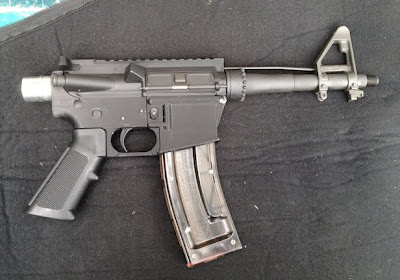
3D printed .22 pistol. Courtesy of HaveBlue
Latest News
July 27, 2012
Kind of like the Force (and duct tape), technology has a light side and a dark side. This is true for even the most basic tech. Fire can cook your meal or burn down a house. It’s tempting to focus on the bad and overlook the good. Just like in school, the bad kids got more attention than the good kids, but a smart teacher doesn’t paint all children with the same brush.
The rise of 3D printing will bring out the good and bad in people, just like every other technology. For every 100 people that print out a doorstop, you’ll have a couple using the technology to pirate objects and designs. I’ve covered some of this ground in earlier posts, but I thought it might be worthwhile examining the issue from a different angle.
Are you the type of person that prefers good news first or bad news first? I’ll start by talking about the bad, with the idea that the good can inspire you near the end.
A gun enthusiast that goes by the internet nom de plume of HaveBlue has figured out a way to build a pistol and half of a rifle using a 3D printer. In light of recent events, I find this troubling. Let me clarify that this isn’t a call for gun control, this is a call for caution. You might not take issue with adults printing out large portions of an AR-15, but what if some kids give it a try?
HaveBlue was able to build a .22 pistol using an old 3D printer. Obviously most of the “guts” of the weapon weren’t printed, but as the technology improves, printing an entire functional firearm isn’t totally ridiculous to contemplate. I suspect that some of the metal sintering systems might be able to pull it off already.
What concerns me about this is the possibility for lawmakers to overreact to the news. 3D printing is already generating some negative attention in regards to intellectual property, and it would be a shame to see this potentially transformative technology saddled with heavy legislation before it really gets started.
Now for the good news. Combining additive manufacturing (AM) with printed electronics is turning into a field all its own. Optomec and Stratasys already proved the merging of technologies is feasible and other companies have begun to develop it as well.
Xerox has been experimenting with using trace amounts of silver as a conductive material for inkjet printing. Silver is actually a better conductor than copper, but is usually too expensive to be used in such a manner. Possible uses for this idea include printing flexible display screens and antennae.
Add to that the ability for AM to build batteries and you could manufacture most smart phones and other tech gadgets without sending the majority of the labor out of the country. That leads to a future of shortened supply chains, less of a carbon footprint and is a general win for consumers and manufacturers alike.
Below you’ll find a short video that demonstrates a rather more benign use of 3D printing to create a toy gun.
Sources: Dvice, The Economist, Refreshing News
Subscribe to our FREE magazine, FREE email newsletters or both!
Latest News
About the Author
John NewmanJohn Newman is a Digital Engineering contributor who focuses on 3D printing. Contact him via [email protected] and read his posts on Rapid Ready Technology.
Follow DE






